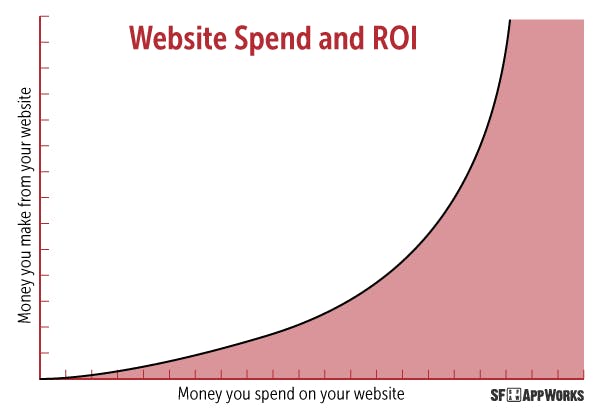Building a website requires introspection. Though it’s tempting to jump right into the ‘building’ part, if you don’t take the time to carefully consider your objectives and resources, then you and your stakeholders are going to end up frustrated and disappointed. Don’t be frustrated and disappointed. Instead, consider these FOUR things before creating a website.
1. What is the goal of your new website?
In our early days, when a client told us that they wanted a website, we nodded our heads and began asking questions about the look and feel of the website. We would build the website to spec and the website would go live, but we wouldn’t really know whether we had ‘won’ or not.
The problem is, nobody just wants a website…they WANT a result. Imagine you run an e-commerce site that sells shoes, and you want a website. What do you actually want?
To increase sales revenue from the website? A website optimization audit should be your first step. You’d want to look at your current SEO efforts, keyword ranking, conversion rates, and analytics strategy. There’s a good chance you can increase sales revenue by tweaking your existing website and save yourself the hassle of building a new one.
To find distribution partners to get your shoes into brick and mortar shops? In that case, you might only need a few qualified leads to get the ball rolling. Your website might focus purely on educating your leads on your great shoes, and ignore supporting high traffic or e-commerce transactions. Perhaps an interactive website experience taking your users through a factory tour, paired with a highly targeted social media campaign, would do the trick.
To appear on the front page of Google search results? Your website should revolve around content and landing pages, and be heavily optimized for SEO. That means spending money on writers instead of developers and distributing your content in as many places as possible.
To build a website that investors will find flashy and elegant so that they are more likely to invest? Make speed and high quality animations your number one priority (read: Don’t build on Wordpress).
The point is, until you know your goal, you can’t pick a strategy.
Related: What Are The Most Common Web Development Services
Get A Free Copy Of 'How To Tackle A Website Redesign'
%20(1)%20(1)%20(1)%20(1)%20(1).png?width=579&height=411&name=website%20redesign%20resource%20image%20(4)%20(1)%20(1)%20(1)%20(1)%20(1).png)
2. Who is going to write and update all of the content?
One of the biggest ‘slower-downers’ of website projects is the back and forth between client and developers discussing what content to put on the website, and how to put it there. Knowing the amount of words, pictures, and videos on each page is going to define your layout, yet most people throw Lorem Ipsum on a page and punt thinking through what they actually want to say to the end user. DON’T DO THIS. STOP IT.
Going through the messaging process will force you to clarify your goals. You’ll encounter tough decisions and, having made those decisions, your priorities will change. It will cost you much more time and money if your priorities change after development of your website is underway.
Relatedly, you should think about who is going to be updating the content once the website is live. Many assume they need a Content Management System (CMS) without considering the costs and benefits. Being able to update the content yourself is a big benefit, but it doesn’t come for free. If you pick a popular CMS platform like Wordpress, you’ll be relying on a backend that is slower, less scalable, and in need of more maintenance than a simple, custom (and modern) backend. Beyond that, every time you want to update the front end design, you need to spend time updating the CMS too.
In reality, most people don’t take the time to learn the CMS that they initially insisted on, and the time we spend creating and making user friendly admin panels and detailed tutorials is wasted. Instead, we get emails asking for updates when clients need them…which generally isn’t very often. Building without a CMS might require a few hours/month of developer support to update web copy, but it can save a lot of time and money upfront AND lead to a faster and more scalable website.
Related: Software Development Companies in USA with Top Software Solutions
3. What kind of traffic do you expect?
Knowing how much traffic you get, what kind of traffic you get, and what your traffic is going to do when they get there is critical in determining your backend architecture. You can spend months optimizing your website to handle tens of thousands of concurrent users, which could be critical if you run an e-commerce platform with heavy traffic, but pointless if you manage a law firm website that won’t ever get more than 10 concurrent users.
Further, the more traffic you expect, the more device types and operating systems you have to account for. Do you want your website to work on Windows 8? How about Opera? The original iPhone? How thorough do you want your Quality Assurance testers to be when running load tests and cross browser compatibility? It all depends on how much (and what kind) of traffic you expect.
We all hope for great success in our ventures, which often means a lot of traffic to our ventures’ websites, but you don’t necessarily need to build the support system for a massively scalable site from day one. However, if you know you’re going to be featured by Starbucks or Oprah, as was the case with two of our clients, then take the time (and investment) to optimize assets, setup a scalable server configuration, and decouple from a bulky backend platform that might have been built for functionality over scalability.
Beyond that, your traffic is the blood of your website, flowing through every page and touching all major organs of your marketing machine. Understanding what kind of traffic you get is akin to creating customer personas, which will be the basis of your targeting efforts. Making sure you have enough traffic to analyze your user funnels will be critical to your analytics strategy, which should in turn drive product decisions. Having too much traffic is a great problem to have, but not having enough can be crippling to your decision making process.
There are many ways to acquire users – whether it be paid, through content generation, business development, outsourcing salesforce, or co-marketing opportunities. Once you have a target, you can fine tune your architecture and analytics strategy to those expectations.
4. What is your budget for creating a website?
If you have a $5,000 budget, there is no point of exploring a $50,000 solution. But there’s also no point in spending $5,000 on a website that doesn’t accomplish your goals. You might be better off spending $50/month putting up a simple landing page from a template website platform and $4,500 running a small user acquisition campaign to test out your return on investment. Technology development is costly and there is a lot you can do to test your theories before you begin coding.
Once you know your budget, you have to decide whether to share that with your bidding development agencies or accept blind bids. Neither approach is wrong; both have benefits. Accepting blind bids might result in a lower bid than your budget, but it also might result in a higher bid, forcing you to cut features, or pick an agency whose strategy is to compete on price. More often than not, you get what you pay for.
This is especially the case when you hire service people who are competing on price. They are, by definition (and necessity), prioritizing saving money over quality, speed, or scalability. Sharing your budget, on the other hand, will enable your bidding agencies to do what they should do best – consider the available resources and the desired outcome and propose the best solution.
Another thing to consider – If saving money is your number one goal, then you may need to spend more time thinking through your website objectives. If you are running a business, then building a website is an exercise in making money, not saving money. If you’re doing it right, your website spend and ROI should ideally look like this:

What I Left Out
There are a hundred things you should consider before building a new website, but I focused on these four because they are the most critical in determining your website architecture, and they are the most important to consider up front.
Also, many of the specific considerations can be rolled into these big four. For example, hosting and maintenance is part of your “how much traffic do you expect” analyses, and your overall content strategy folds into the “who/how/when will you update content” question.
It’s not to say these aren’t important to consider individually, but my goal here is to help you prioritize into big buckets rather than overwhelm with minutiae.
Let me know what you think and if you have any ideas for future posts, please share them with me!


COMMENTS